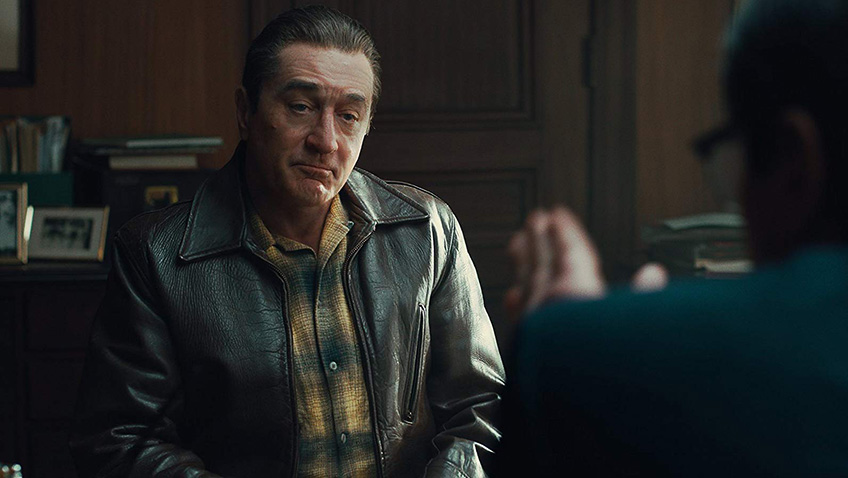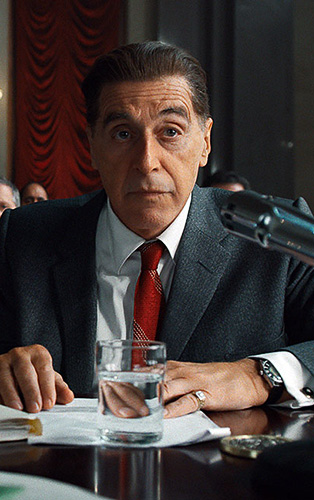Joyce Glasser reviews The Irishman (November 8, 2019), Cert. 15, 209 min.
The ninth film director 76-year-old Martin Scorsese and actor Robert De Niro, worked on together was Casino, nearly a quarter of a century ago. And it might have been their last collaboration had writer Eric Roth not given De Niro Charles Brandt’s book I Heard You Paint Houses, based on Brandt’s interviews with Frank ‘The Irishman’ Sheeran. Sheeran was a Pennsylvanian truck driver, WWII veteran, fixer for the Pennsylvania mafia, Teamster boss and hitman, active in the mob from the 1950s to the 1970s. Scorsese has turned this 2004 memoir into a chilling, magnificently acted and subtly directed work of art that engages the viewer intellectually, if not emotionally.
 This is prime Scorsese territory, (Mean Streets, Goodfellas, Casino, The Departed) and a fitting reunion for an elite group of septuagenarian actors who appeared in Mean Streets or Goodfellas: De Niro 75, (Sheeran); Harvey Keitel, 79, (playing ‘The Gentile Don’, Angelo Bruno); and Joe Pesci, coaxed out of retirement at age 75 to play the quietly terrifying Philadelphia mafia boss Russell Bufalino. Also invited to the reunion are Thelma Schoonmaker, 79, – Scorsese’s editor for the past 50 years, and Gang’s of New York scriptwriter Steve Zaillian, 66.
This is prime Scorsese territory, (Mean Streets, Goodfellas, Casino, The Departed) and a fitting reunion for an elite group of septuagenarian actors who appeared in Mean Streets or Goodfellas: De Niro 75, (Sheeran); Harvey Keitel, 79, (playing ‘The Gentile Don’, Angelo Bruno); and Joe Pesci, coaxed out of retirement at age 75 to play the quietly terrifying Philadelphia mafia boss Russell Bufalino. Also invited to the reunion are Thelma Schoonmaker, 79, – Scorsese’s editor for the past 50 years, and Gang’s of New York scriptwriter Steve Zaillian, 66.
Working for the first time with Scorsese, as the uncompromising Teamsters’ Union boss Jimmy Hoffa, is 79-year-old Al Pacino who makes up for lost time by dominating the film. Pacino’s introduction to the genre was at the very beginning of his career in The Godfather made by Scorsese’s contemporary, Francis Ford Coppola eight years before Goodfellas.
Scorsese’s use of music is legendary, and here the Five Satins cover for the Cole Porter song In the Still of the Night, serves as an ominous rather than a romantic theme song. We first hear it when the camera pans through a nursing home finding its way to an elderly Sheeran as the chorus, ‘I remember, I remember’ prepares us for the older man’s reminiscences. This man is Frank Sheeran, but by the end of the film you might suspect Scorsese is looking back, too, on the gangsters that were part of his heritage and legacy. The Irishman is saturated with the stench of death.
Schoonmaker conducts us smoothly around an elaborate, two-tiered flashback structure in which Frank in an armchair tells us – or another interlocker off camera – his story. Within this flashback is another: a road trip that Sheeran, middle-aged, takes with Russell and their wives. Irene (Stephanie Kurtzuba) is Frank’s second wife – his first wife, like most women in the film, written out of this macho history). The trip from Kingston Pennsylvania to Detroit is ostensibly to attend a wedding, but it has the symbolic role and the pace of a funeral march. When the two couples stop on the road so that their wives can smoke (Russell is smoke intolerant) Frank sees the Texaco station where, thirty years earlier, he and Russell first met after Russell fixes Frank’s engine. Frank tells us he thought the stranger owned the gas station and later found out he owned the whole street.
When Frank’s attempts to break into the meat delivery business by less than honest practices, he is caught and charged with theft. He finds himself defended by William Bufalino (Ray Romano) who is such a smooth operator that the judge is practically apologising to Frank for the inconvenience of dragging him to court. William’s cousin Russell sees something in Frank that he likes. Frank served in the army in Italy – that is where an Irishman learned to speak Italian. (Since De Niro is about as Irish as Woody Allen, he wears blue tinted contact lenses, but it doesn’t help). In any event, Russell wants a man who follows orders, was conditioned to killing in the army and never took leave. Frank becomes Russell’s fixer.
Despite one cock-up when Frank thinks for himself instead of following orders, he is promoted from fixer to assassin. Don’t expect noisy gun battles, blood and guts. All the romance and excitement has been stripped out of the violence and the mafia who do not display their wealth – they stay at Howard Johnsons motel chain – and are unable to enjoy it. Scorsese shoots Frank’s hits as though he were changing a light bulb – or putting one out. He is much more interested in the language of the mafia and it is from this that the film’s humour derives.
The dons speak in euphemisms: to paint a house is to kill someone; if you do a bit of carpentry you clean up after; and ‘not that’ is an order to hold off on killing someone. Arguably the most suspenseful scene in the film is constructed around indirect verbal messages. At a big dinner where Frank’s Teamsters’ Union leadership is celebrated, he is shown for what he really is: not a big shot, but a hapless go between. Russell relies on Frank, who Hoffa trusts, to get the message across. ‘They told the old man to tell me to tell you, that’s what it is,’ Frank tells Hoffa. ‘That’s what it is’ means if Hoffa does not voluntarily stand down, he will be taken out.
Earlier in the film Hoffa asks his new friend, Sheeran, ‘Would you like to be part of this history’, referring to the Teamsters’ role in America, which includes its role in financing the mafia with its huge pension pot. The mafia families involved in building Las Vegas found it more difficult to establish a line of credit with Bank of America. Hoffa’s control over the purse strings paved the way for his ‘disappearance’, although as history here is seen through the eyes of an unreliable narrator, Frank takes credit in a scene that seems intentionally confusing and unconvincing.
The occasion when Frank assassinates Crazy Joe Gallo (Sebastian Maniscalco) at Umberto’s Clam House while he is celebrating his 43rd birthday with his family is one of the few hits dramatised at length, and there is independent evidence that Frank Sheeran was the hitman. And as we move through Frank’s history, all those conspiracy theories that link the mafia with mainstream politics tend to sound more probable. The assassination of John Kennedy is the result of betrayal. The Mafia supported his election and the Bay of Pigs attack to get their lucrative Cuban slot machine business back, but that didn’t happen. We even see Frank driving down to Florida with a shipment of arms delivered to a guy with ‘big ears’ named Hunt – later seen in a TV broadcast as one of Nixon’s plumbers in Watergate. The film goes into some detail about Hoffa’s hatred of Attorney General Robert Kennedy, who imprisoned him, leading to the implication that the assassination was retaliation.
To tell this epic, which begins when Sheeran is in his twenties, Scorsese makes use of a new de-aging process that assured the film’s essential continuity of acting talent. The story would have impossibly confusing, not to mention uneven, if each of the stars had one or two different sets of younger actors playing them overtime. This is face and body Botox that does not interfere with facial expressions – or correct the rest of the body’s natural ageing. While the technology it is far from perfect, it works reasonably well in the middle years.
While women (Frank had two wives and four daughters) are barely at the margins of this story, Frank’s estranged daughter Peggy (played by Lucy Gallina as a child and Anna Paquin as an adult) is the film’s moral compass. She is traumatised when she witnesses her father’s violent overreaction to her minor complaint about a local shop owner and grows up aware of his father’s role in life, an awareness that is confirmed when Russell, Frank and several of their cronies go to jail as old men (where Russell dies). If Peggy represents the viewer in being unimpressed with this empty power game, a bit more dramatisation of her point of view might have added an emotional edge to a chilling masterwork.
You can watch the film trailer here:






